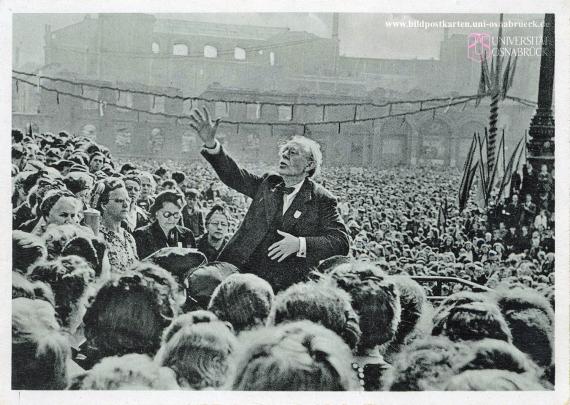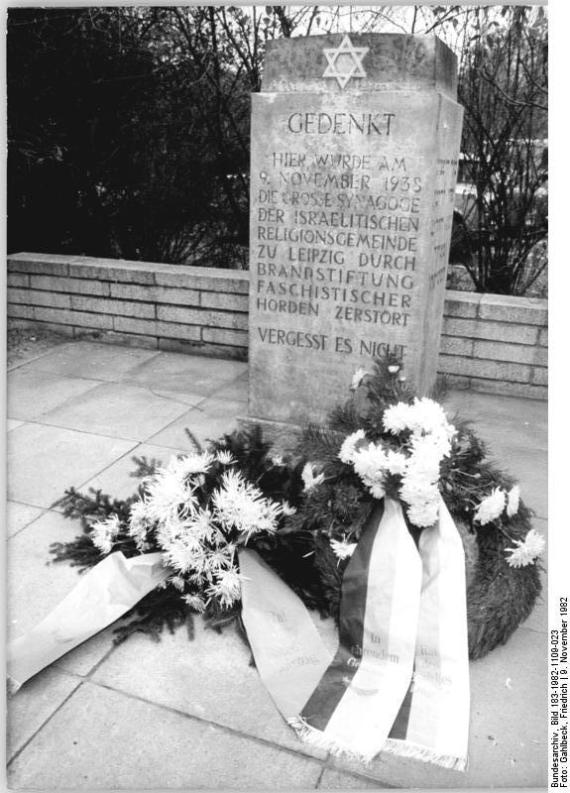The Jewish Religious Community in Leipzig after 1945
Before 1933, Leipzig was one of the largest communities in the German-speaking world with over 11,000 members. Immediately after the liberation, only twenty-four people of Jewish origin were still living in the city. However, on May 15, 1945, the Jewish Religious Community of Leipzig was able to reconstitute itself and move back into its former offices in Löhrstraße. Richard Frank took over the chairmanship and the community grew significantly in the coming months thanks to returnees.
Help & organizing
Many Jewish survivors sought help in the community center, so the municipal administration soon took over the provision of accommodation, food and medicine. People seeking help from Eastern Europe also came. They were either accommodated in the building of the former Beth Jehuda Synagogue at the expense of the community or in displaced person camps run by the American occupation authorities in barracks in the north, which even provided its own rabbi. Non-members of the community also organized themselves, for example around the lawyer Dr Hans Birckner in the "Interest Group of Formerly Racially Persecuted Persons", which he founded in 1945.
Memorial & community life
The community endeavored to restore the Jewish cemeteries. A memorial was inaugurated on May 8, 1951 on the site of the destroyed ceremonial hall of the New Jewish Cemetery. Two years later, work began on a new mourning hall and the memorial was moved within the cemetery. The synagogue in Keilstraße, which was not completely destroyed, was able to hold its first service again on Rosh Hashanah in September 1945. A holiday was also celebrated again for the first time in 1946 in the Beth-Jehuda Synagogue, which had been misused as a "Jews' house" during the Shoah. During the GDR era, however, the production facility of VEB Bettwaren moved in. Until the renovation in the mid-1990s, a faded Star of David could still be seen on the ceiling.
The SED leadership's anti-Zionist campaign from the end of 1952 also caused uncertainty in the Leipzig community and led to 64 members fleeing. The loss of important board members prevented continuity and the concerns of the community went unnoticed by the GDR state.
Increasing ageing also led to a loss of members in the following years. The 10 men required for a prayer - a minyan - could not always come together. Members of the Plauen, Delitzsch and Zwickau Israelite religious communities soon joined the Leipzig community.
Restitution & "Wiedergutmachung"
The lawyer and administrative director of the former community, Fritz Grunsfeld, was an early advocate for the restitution of Jewish property confiscated by the Nazi state or sold under duress. The chairman of the Leipzig community, Helmut Salo Looser (1908-1993), a concentration camp survivor and former member of the Zionist-Socialist youth group Habonim, was also critical of the issue of "restitution". In order to secure the claims to the old property, the decision was made to retain the name "Israelitische Religionsgemeinde Leipzig". Several former Jewish properties - e.g. the former synagogue sites - were soon transferred back to it.
Change from the 1960s onwards
Leipzig was considered a cosmopolitan community. This was also reflected in visits by former residents, for example the Association of Former Leipzigers in Israel. From 1973, representatives of the Jewish community sought contact with the "Working Group Church and Judaism". Four years later, Eugen Gollomb (1917-1988), a Polish Auschwitz survivor and chairman of the congregation, was the first Jewish speaker at their annual conference. In cooperation, a commemorative event was held in Leipzig's St. Thomas Church to mark the 40th anniversary of the November pogroms, and from 1979, regular events were also held to impart knowledge about Judaism and educate people about everyday anti-Semitism.
New free spaces
In the 1980s, institutional and individual freedom increased for the small number of practicing Jews in Saxony. One example of this is the experience of Chaim Adlerstein, Aron Adlerstein's grandson, who grew up in the Leipzig Jewish community. Shortly before the end of the GDR in September 1989, Aron and some friends were allowed to take part in the 6th Summer University of the European Union of Jewish Students in northern Italy. Previous invitations had not even reached him due to the GDR government's refusal. The upheaval in society as a whole also made itself felt when the Leipzig "New Forum" organized a silent march on the anniversary of the November pogroms, which led to the memorial stone on Gottschedstraße after a prayer for peace in the Nikolaikirche.
1990s to today
The first immigrants from the former Soviet Union arrived in Leipzig in July 1991. By October 1994, 60 people from cities such as Kiev, Odessa and St. Petersburg had already joined the Leipzig Jewish community. Some experienced right-wing extremist violence. Writer Dmitrij Kapitelman, who came to Leipzig-Grünau from Kiev with his parents in 1994 when he was eight years old, recounts: "It was absurd: we left Ukraine because we were told that Jews in Eastern Europe were threatened by anti-Semitism and that Germany had a historical responsibility for them - and then you experience the farce of being surrounded by Nazis in East Germany and having to run for your life."


Add new comment